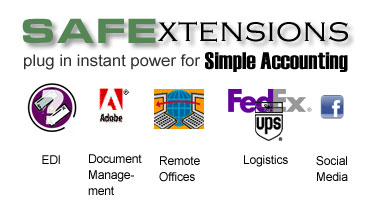Suggestions On Setting Up Products & Services
How you set up your Products and Services has a tremendous impact on how you use Simple Accounting.
The most common question we get asked is How do I select a Product ID? Why are these IDs so important? First, because you cannot easily change them once they are entered (except in Security Extensions). Second, because the Product ID is the primary way you will look up or refer to the Product so it should be:
Meaningful
Unambiguous
Easy to remember
Consistent
Our Suggestion: The easiest answer is to let Simple Accounting do it for you using the built-in formulas in FILES|Setup Global Options under the Record ID tab. The four basic choices have proven to cover most distributors needs. However, if you have extra special needs, you can enter a formula to custom assign these in Security Extensions.
Specs Or No Specs?  A product may have a spec, which you can edit using the Specs button at the top right-hand corner of the browse window. These specs are printed on RFQs and purchase orders. If a product has a spec, it will display the above little icon at the far left of the browse. The type of spec that prints is determined by the products Product Type.
A product may have a spec, which you can edit using the Specs button at the top right-hand corner of the browse window. These specs are printed on RFQs and purchase orders. If a product has a spec, it will display the above little icon at the far left of the browse. The type of spec that prints is determined by the products Product Type.
Our Suggestion: Never use a Spec unless you actually need one!. For example, if you order a product which does not conform to one of our standard Spec data entry screens, you probably dont need a Spec. Or if you order standard labels, envelopes, etc. from a catalog that require no special printing, or only a few special instructions, do not use a Spec. In these cases, simply indicate your Special Instructions to the vendor in the Vendor Notes box when ordering the item.
Ownership: Products may be or may not be subject to inventory control and/or forms management. There are many possible scenarios (warehousing customer-owned forms, pick and pack, storage at customer site, etc.), for which well discuss the details in the next section. For now, well say that all inventory control is determined by Ownership.
 Who owns the product? This does not mean where is the product stored. For example, your customer may have bought and paid for the product, even though it is being stored in your warehouse. This also does not necessarily mean a stock item which your sell to many customers. The product could be bill as shipped–where your company bought and paid for the product even though it is only being billed to your customer as partial quantities are released.
Who owns the product? This does not mean where is the product stored. For example, your customer may have bought and paid for the product, even though it is being stored in your warehouse. This also does not necessarily mean a stock item which your sell to many customers. The product could be bill as shipped–where your company bought and paid for the product even though it is only being billed to your customer as partial quantities are released.
Our Suggestion #1: If you buy it and sell the same Product ID to more than one customer or to a single customer and all orders are bill-as-released mark the Product as Distributor Owned
Our Suggestion #2: If you buy and sell the Product ID to a single customer and they pre-pay for orders which are then released from either your warehouse or a vendor, mark the Product Customer Owned.
Our Suggestion #3: If you need to track products which were purchased from other distributors. Mark them as Vendor Owned. This allows you to track their usage, even though you are not the party who is purchasing/reselling the item..
Our Suggestion #4: All other Products should probably be marked as N/A. If you order the Product drop-ship to a single customer, mark this field as N/A.
Usage Calculation How should average usage be calculated for this product: by sales, counts, or releases?
Our Suggestion #1: Set products and services to N/A for which you have no need of inventory control or forms management. This will speed execution of the program.
Our Suggestion #2: Set products and services to Calculate Usage by Counts only if you really do take physical counts of the product every month.
Calculating Reorders? Should Simple Accounting calculate when it is time to reorder a product based on calculated usage, or should it flag the product to reorder based on a fixed number or date you have entered (see below for options)?
Our Suggestion: Disable this field unless you need Simple Accounting to predict the quantity you will need to reorder based on past usage. This will speed execution of the program.
Linked To A Customer A product may be linked to a customer and one or more shipping addresses (SITES) in the CUSTOMER ID field. This prevents you from selling the product to any other customer.
Our Suggestion: Only link products to customers when the product will be used exclusively by that one customer (or another customer within the same Corporation.



